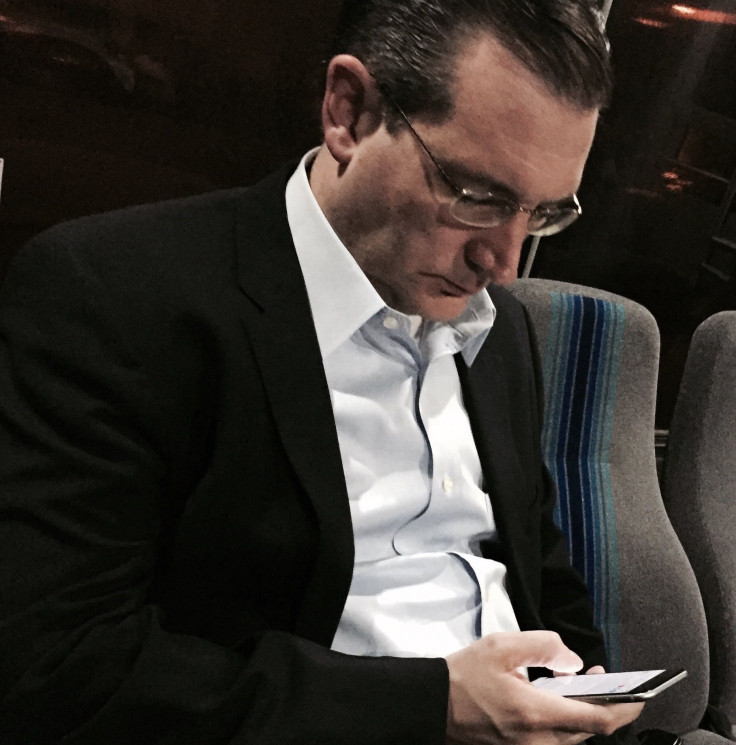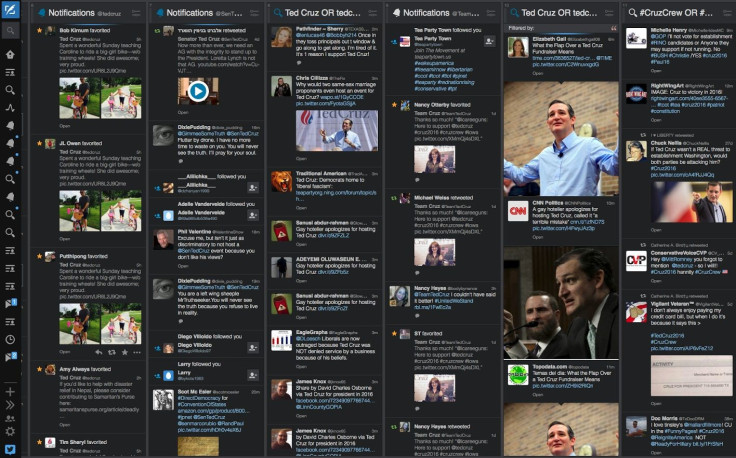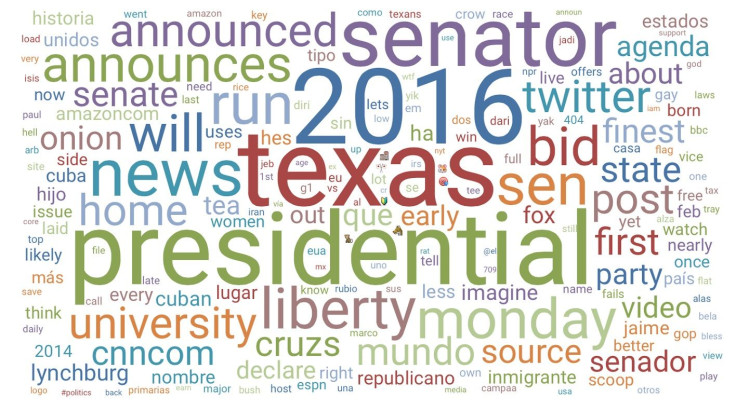How Ted Cruz Keeps It Real On Twitter: Meet His 26-Year-Old Digital Guru

Mention @tedcruz on microblogging site Twitter, and Senator Ted Cruz’s iPhone 6 will light up. Between Senate hearings, public campaign events and time at home, the junior senator from Texas and one of three, so far, vying for the 2016 Republican presidential nomination, is constantly plugged in.
Even as the senator’s account grew from 3,000 followers in 2011 to over 400,000 as of Thursday, he has yet to disable the notification feature. "I'll look over and his screen is constantly on because of the notifications," said Josh Perry, Ted Cruz's new media director. "For me, I can't look away when I see my phone light up. He stays attentive in meetings, but he's constantly watching Twitter."
Cruz may not be the biggest in social of the candidates in the race -- Rand Paul has 1.9 million Facebook followers to Cruz’s 1.2 million -- but he’s by far the most accessible. In social media, the Ted Cruz you get is really Ted Cruz. Indeed, the only layer between the candidate and the public is his 26-year-old digital campaign manager Perry, who joined Cruz in 2011 soon after graduating with a political science degree from the University of Texas in Austin.
Perry found his way to Cruz’s first Senate campaign as a strategist at Austin-based Harris Media, a digital consulting firm that advised Rick Perry’s and Newt Gingrich’s 2012 presidential campaigns. Founder Vincent Harris signed on to manage Kentucky Sen. Rand Paul’s digital team. Perry remained with Cruz.
Since then, the contrast in style between Cruz and Paul has been stark. While Paul has built a formidable campaign infrastructure -- a staff of six do his tweeting -- Cruz has pursued a lean, more endearing strategy. Paul, for example, has been dubbed a “troller-in-chief” due to aggressive tactics on social media such as releasing a fake "secret tape" of Hillary Clinton and Jeb Bush and creating a Facebook photo album called #HillarysLosers.
Cruz, instead, uses the site to promote initiatives and has been known to directly engage with his constituents rather than his contenders. For example, after a supporter tweeted that she spent eight hours tabling for him at an event, Cruz replied with a public thank you. This personal engagement is a strategy Newark, New Jersey, Mayor (now U.S. Sen.) Cory Booker gained attention and respect for in 2010.
Defining Cruz online has been Perry’s role since he first joined the campaign in 2011, credited as the master behind Cruz’s Facebook and Twitter. “Up until month ago, most of my time was spent in a federal office. Now personally I enjoy diving down into what people are saying, seeing what the most resonating messages are and engaging with them,” Perry said.
Experts have credited Cruz’s digital focus and social media use to his Senate victory, where he was up against a more funded opponent. One political scientist told Politico, “Ted Cruz is the Barack Obama of 2012” due to his grassroots tactics to build a movement and win.
That’s not to say a presidential race can be won by whichever candidate has the most Facebook likes. A recent poll highlighted that the Republican party is divided on whether to back the most conservative player or one who could beat the Democratic nominee. But with Perry still at the head of digital, the Cruz team has taken its grassroots strategy to the national stage.
With his entrance into the presidential race, Cruz and Perry’s digital focus was clear. He had previewed his announcement via a Facebook post and then tweeted the candidacy at midnight with a short video, all before Cruz gave a speech at Liberty University in Lynchburg, Virginia, the next day. “We had a long presence on Twitter that we wanted to take advantage of. The biggest thing for us was being able to see the enthusiasm instantly,” Perry said.
A ‘Vulcan-Mind Meld’ Duo
Cruz has both Facebook and Twitter on his phone and has posted himself. But more often, Cruz will email suggestions, such as news articles and photos he would like to share, to Perry.
“It takes time to find your distinctive voice and style and to grasp with precision what resonates with your audience,” Don Willett, a justice on the Supreme Court of Texas who has been viewed as a prolific Twitter user, wrote in an email. “Ted actually tweets himself sometimes, but you can’t tell which are his and which are Josh’s. That’s exceedingly rare.”
Perry will sometimes let his own personality and self-proclaimed obsessions, such as Taylor Swift, influence his posts for Cruz. He noted that the Senator has some “geeky” tendencies himself, recalling a Star Trek impression Cruz once did in a team meeting (Bloomberg Politics later captured it on video) only to have the room be confused.
“‘Here I thought I had hired a bunch of geeks,’” Perry recalled Cruz saying.
Perry critiqued the Clinton campaign’s strategy where Twitter posts supposedly written by Clinton herself are signed with an H. “So what you’re telling me is every other one that person has no role in?” Perry said.
While Cruz is speaking at event and staring at a crowd, Perry is at a computer watching TweetDeck, a dashboard application for Twitter, to see what constituents are saying. Perry will post quotes or create video snippets from the event.

During events, Perry is focused on making content digestible and shareable such as packaging videos. “No one’s going to be sitting on their phone and watching a video on Facebook for 30 minutes. But they’ll watch 45 seconds, 30 seconds, 15 seconds at a time,” Perry said.
The Digital Strategy: Navigating The Noise
Engaging on Twitter and creating short videos is one tactic Perry has used for awhile. After Cruz’s infamous 21-hour speech against Obamacare, he had read aloud tweets Perry previously solicited from Twitter. Perry also translated the marathon speech into a viral video.
Currently, Cruz has 1.2 million fans on his Facebook page. When Perry joined the campaign there were about 30,000 Facebook likes. When Cruz was elected to the Senate, that number had grown to 100,000.

Perry has witnessed similar growth on Twitter. “There used to be a time where I could literally see every mention of Ted Cruz, back in 2011,” Perry said. “I have more columns in TweetDeck than I can possibly do anything with.”
And from that, the campaign has invested in more tools to navigate the conversations online. Through a partnership with Zignal Labs, they can see a 24-hour breakdown of all mentions on Facebook and Twitter in a word cloud that emphasizes which messages are resonating the most. “We’re able to get a better bang for our buck,” Perry said.

While in the Senate race, Perry served as the primary navigator of online conversations for the campaign, Cruz has since hired a team of 10 people who are tracking what people are saying, creating personality profiles and working on ad targeting. Cruz’s team has also paid for Facebook advertising.
One thing that the Cruz campaign is not investing in, yet: a mobile app. While Clinton may be hiring Android and iOS developers, that may not be in store for Cruz. “I find that there’s very little you can do on a mobile app that you cannot do on a responsive website,” Perry said.
As to engagement on other platforms, Perry said the team prefers to be “really good at a few of them.” They monopolize on Facebook and see great potential in integrating more video. Instead, the campaign’s next move is directed to other fundraising efforts such as setting up GoFundMe accounts. “We can ask people for money on Facebook and Twitter all day, but it means a lot more coming from people,” Perry said.
But can Cruz win? Anshul Jain, a doctoral candidate in the political science department at Boston University and a co-author of “The Social Media President: Barack Obama and the Politics of Digital Engagement,” cited that regardless, it’s probably not the intention.
“I think in every cycle there are people who declare their intention to run, but they know their campaign isn’t viable in the long run. It’s good for exposure, to reposition themselves in the national stage,” Jain said. “The stakes are pretty low. With social media, he still gets the exposure and that exposure is largely free.”
© Copyright IBTimes 2024. All rights reserved.






















